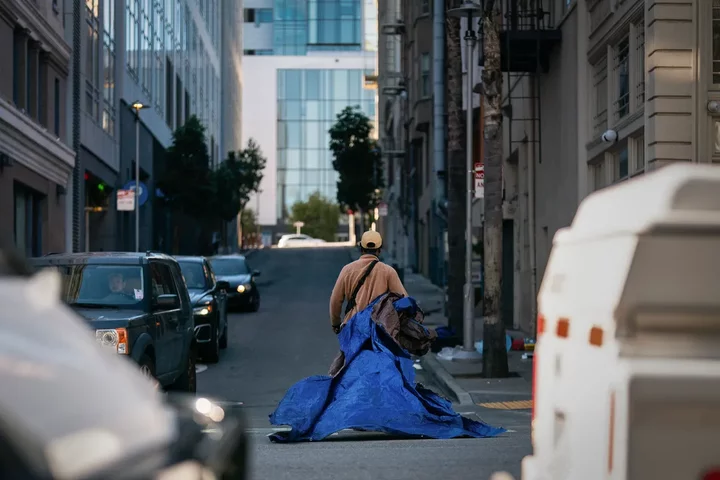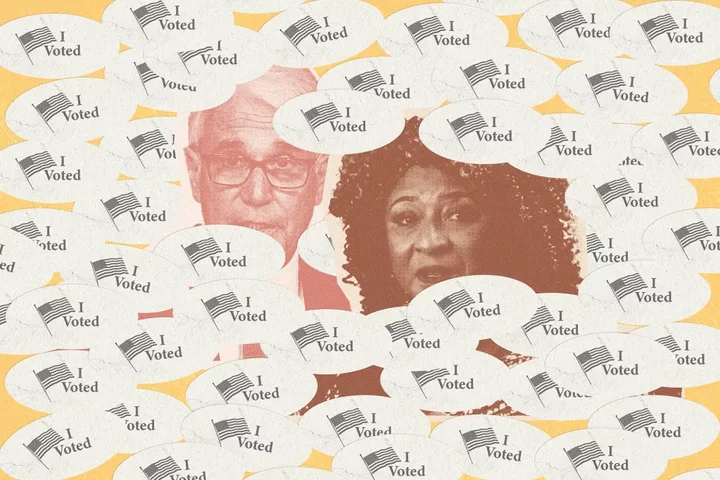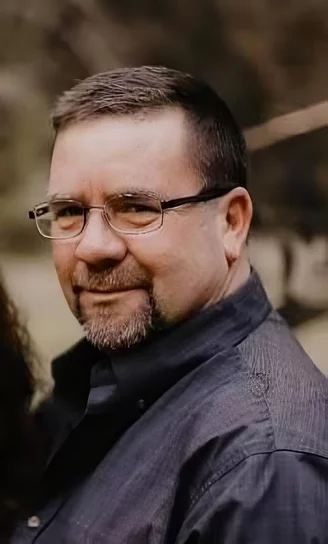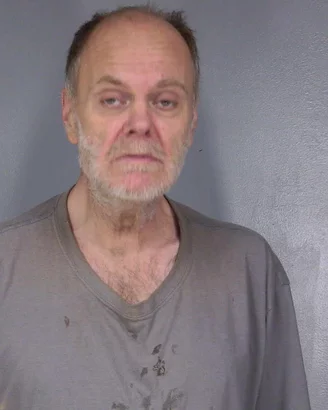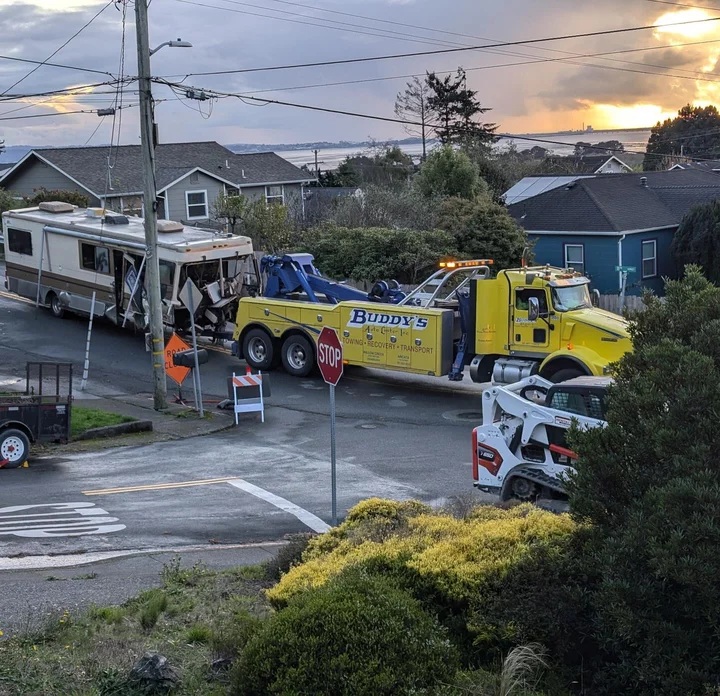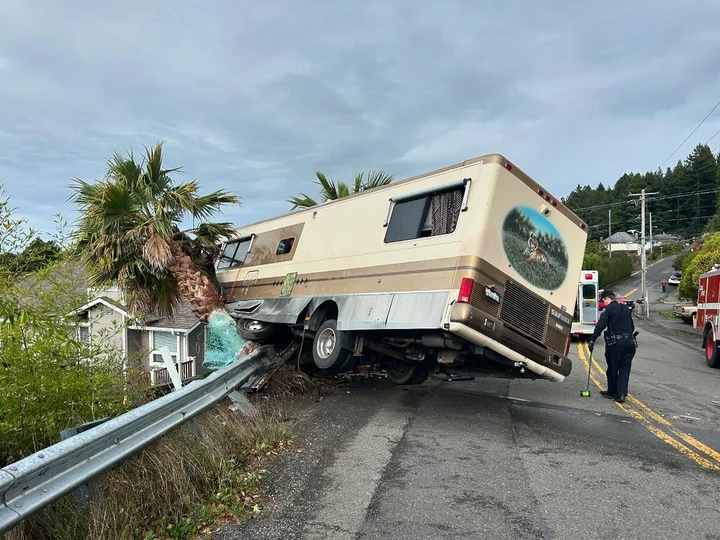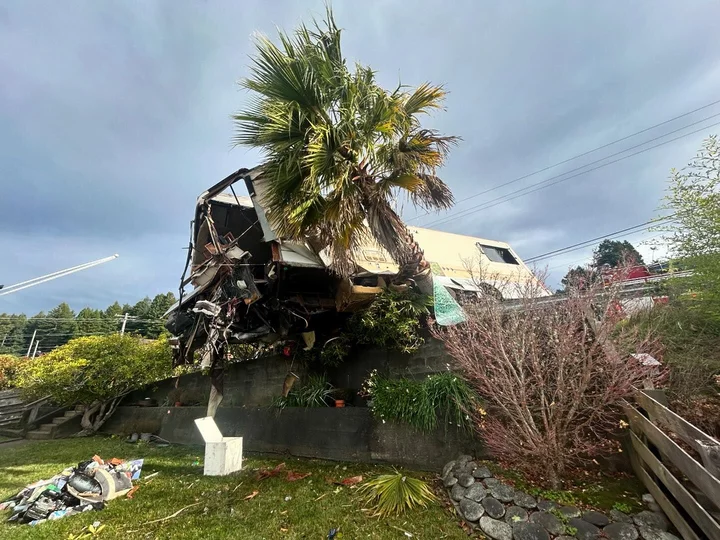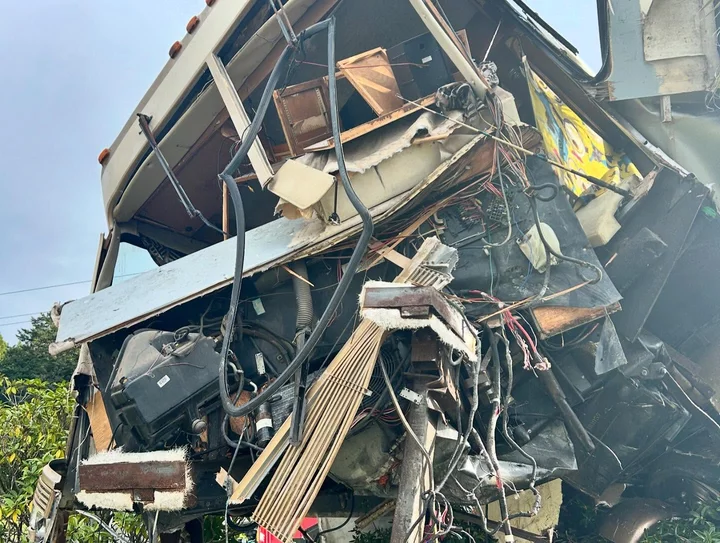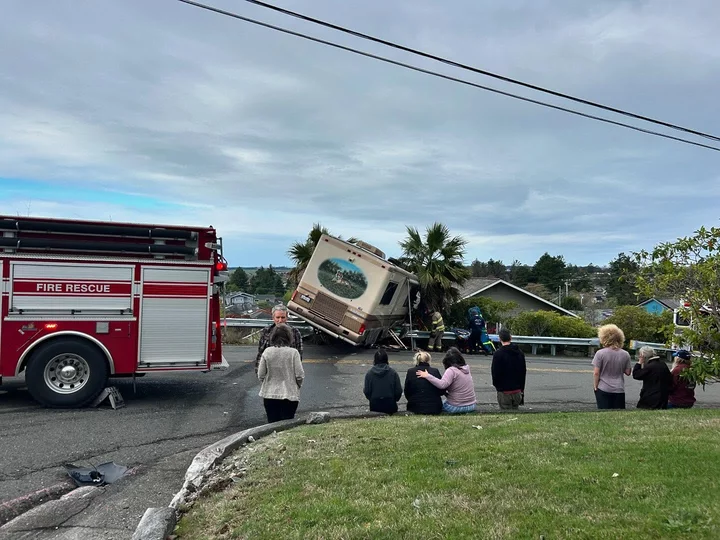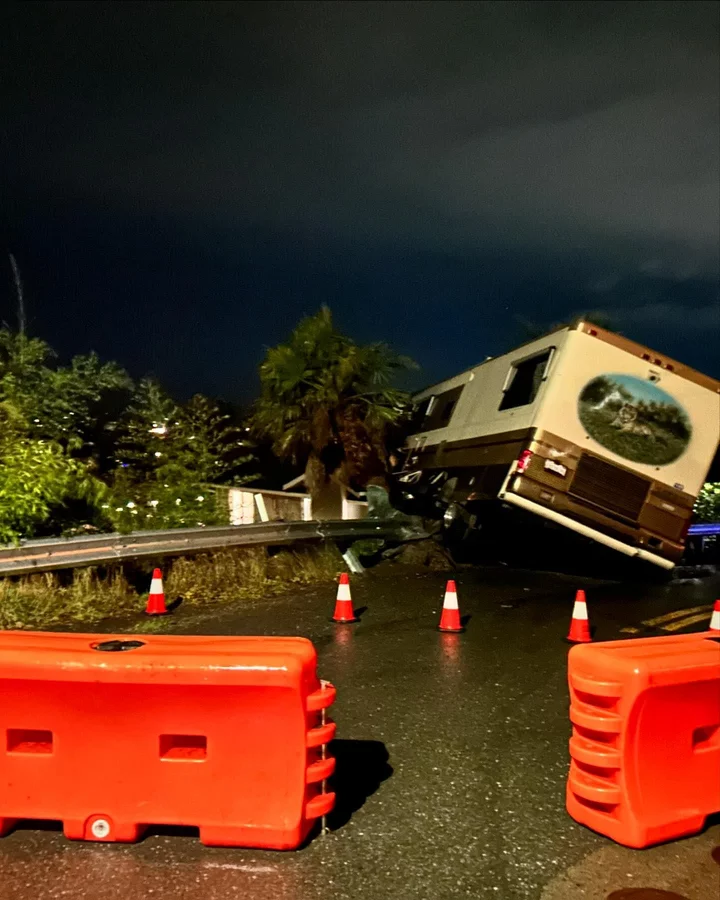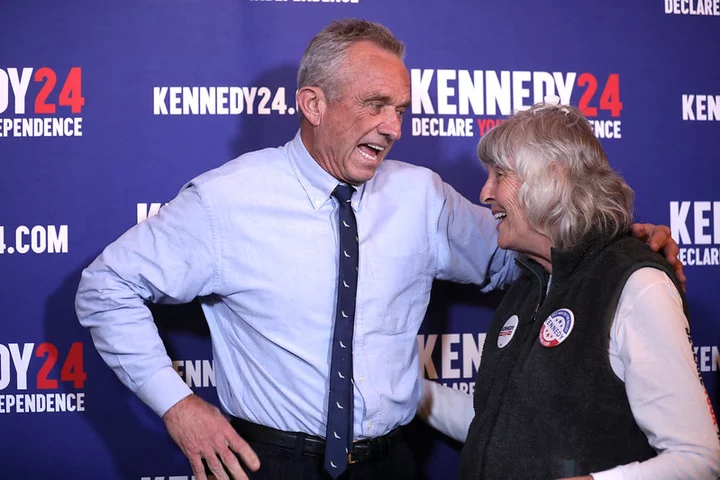Busing People Out of Homelessness: How California’s Relocation Programs Really Work
Marisa Kendall / Tuesday, Nov. 26, 2024 @ 7 a.m. / Sacramento
An unhoused man carries a tarp and some of his belongings across Polk Street during a homeless encampment sweep in San Francisco on Nov. 15, 2024. Unhoused people on Cedar Street are forced to move their shelters and belongings on a regular basis by San Francisco city workers. Photo by Jungho Kim for CalMatters
Mayor London Breed, outgoing mayor of San Francisco, made waves recently with a major policy shift: Before providing a shelter bed or any other services, city workers must first offer every homeless person they encounter a bus or train ticket to somewhere else.
But while San Francisco has gotten an outsized amount of attention for putting its busing program at the forefront of its homelessness strategy, other California cities and nonprofits continue to quietly send small numbers of unhoused people all over the country. At least one new program is set to launch early next year.
For an unhoused person who wants to move in with family in another city or state, or who got stuck somewhere after a job or housing prospect fell through and needs help getting home, these types of programs can be a gamechanger. But some activists worry they can be used coercively to move unhoused people out of sight instead of helping them. And once someone is bused away, it’s hard to tell what happens to them — whether they successfully reunite with family, or become homeless on another city’s sidewalks.
“In general, the ability to travel back to a place where you have a home is really important and can be a lifesaving service, in fact, and can help to reunite families,” said Niki Jones, executive director of the Sacramento Regional Coalition to End Homelessness. “When done in good faith, it can be an important and powerful intervention.”
Many programs do some homework before sending their clients off on a bus, but the amount of effort they put in varies. One nonprofit serving homeless young people in Los Angeles has a therapist call the client’s family in the destination city, to make sure the client is going into a safe, welcoming environment. One of San Francisco’s relocation programs requires the client only to have a vague connection to their destination city.
These programs are garnering attention at a time when city leaders are facing pressure from all sides, including from Gov. Gavin Newsom, to get rid of homeless encampments, but lack the resources to give everyone a home or shelter bed. Buying someone a one-way ticket out of town is a much cheaper alternative. But the number of people who can benefit from these programs tends to be small. Data from throughout California consistently shows that most people who are homeless are from the county they’re in. And homelessness, addiction and other traumas have marred many people’s relationships, leaving them with no one to help them in another city.
San Francisco offers bus tickets before shelter
Shortly after beginning an aggressive crackdown on tent encampments in San Francisco, Mayor Breed ordered all city agencies to “offer and incentivize” the city’s busing program before other services. Those who decline any help may be at risk of being arrested for illegally camping in a public place.
Providing free bus tickets to unhoused people is nothing new in San Francisco, which has been offering some form of this program for about two decades, said Emily Cohen, deputy director of communications and legislative affairs for the city’s Department of Homelessness and Supportive Housing. But usage declined during the COVID-19 pandemic, when travel was restricted, and it didn’t pick back up, she said. The mayor’s directive was intended to fix that, she said.
The increased emphasis on busing also comes as the demographics of San Francisco’s homeless population are shifting. This year, 41% of the people surveyed in San Francisco’s point in time count reported they were living in another city or state when they lost their housing. That’s up from 29% two years ago.
“There are definitely an increasing number of people who are experiencing homelessness in San Francisco who aren’t originally from San Francisco,” Cohen said.
San Francisco offers three programs to help unhoused people relocate outside of the city. Journey Home, launched in September 2023, has the lowest barrier to entry. While other programs require clients to work with a case manager on a detailed plan to find and hold onto housing when they arrive in their new city, Journey Home requires only that someone be healthy enough to travel and prove they have some connection to their destination city. That proof could be a phone call to a friend or relative in the city, a receipt showing the client once got food stamps there, or an ID with an address in that city. Clients do not need to prove they have housing in the destination city, and the whole process, from intake to sitting on a bus, can take a day or two.
Since July 2022, San Francisco has relocated a total of 1,039 unhoused clients via Journey Home and other programs, according to city data.
The number of clients relocated via Journey Home spiked in August of this year (the month Breed issued her order) — 25 people were moved, up from nine the month before. The city relocated another 32 people through other programs. That same month, the city placed 120 people from encampments into shelters, and another 429 people on the street declined help, according to the city.
“In general, the ability to travel back to a place where you have a home is really important and can be a lifesaving service, in fact, and can help to reunite families.”
— Niki Jones, executive director, Sacramento Regional Coalition to End Homelessness
While Lukas Illa, a human rights organizer with the San Francisco-based Coalition on Homelessness, supports programs that help unhoused people who want to relocate, he’s skeptical of Journey Home. The choice to leave San Francisco should be the unhoused person’s to freely make, he said. And he says that’s not the case when police, who have the power to cite and arrest people, offer bus tickets as a first resort.
“Journey Home needs to be so deliberate and to really center the agency and the autonomy of the person it is offered to, and not used as a cudgel to threaten arrest or jail time,” Illa said.
Cohen said no one is being forced to leave San Francisco.
“The intention is to facilitate connections with loved ones and home communities, if that is a safe and healthy option for you,” she said. “But no one is required to take that option.”
Other cities that use homeless busing programs
San Jose has budgeted $200,000 to launch a relocation program called Homeward Bound, which is expected to start in February. That money can go toward a client’s bus or plane ticket, or to help with utility bills or other expenses for the friend or family member taking them in. The city will make sure clients have friends or family to help them in their destination city, but staff are still ironing out the specifics, said Tasha Dean, spokesperson for Mayor Matt Mahan.
“Reconnecting people living on the streets with family members or loved ones who want to care for them is just common sense,” Mahan said in a statement. “It’s the least expensive, most impactful program we could launch.”
Sacramento County also offers those services, but they aren’t widely used, said county spokesperson Janna Haynes. During the 2022-23 fiscal year, 17 people used the county’s Return to Residency Program to leave the county. That program has since dissolved, and now social workers in various county programs offer the service on a case-by-case basis.
The city of Los Angeles doesn’t run a busing program, but multiple nonprofits within the city offer the service. PATH helped 313 clients reunite with family in the last fiscal year, and a little more than half of those clients left LA County.
A Safe Place for Youth also helps young people reunite with friends and family outside LA.
Cities and nonprofits in other states also run busing programs — and sometimes send people to California. Haven for Hope, which operates a large homeless shelter and service center in San Antonio, Texas, gave about 60 people one-way bus tickets out of the city last year, said Alberto Rodriguez, vice president of operations. Before they send a client on their way, Haven for Hope calls the family or friend they are going to live with and confirms the client can stay there, Rodriguez said.
“We’re never just going to send someone back to homelessness in another city or another state, in the same way we don’t want other cities or other states to send their homeless clients to San Antonio without connecting with us,” he said.
Where do people who are bused end up?
Of the 151 people relocated from San Francisco since August, at least 29 went to other cities within California. At least another 12 went to Texas, six went to Florida and seven went to Georgia. Due to a data processing error, the city couldn’t provide information on where 34 people went.
It’s harder to tell what happens to those people once they reach their destination.
San Francisco only recently started requiring staff to check in with clients 90 days after they leave, but staff often can’t get a hold of them in their new city, Cohen said. The city didn’t provide data on the outcomes of those 90-day calls, which started in July, in time for publication.
About 15% of people who left San Francisco through the Department of Homelessness and Supportive Housing’s relocation program between July 2022 and July 2023 ended up back in San Francisco, using the city’s homeless services, within a year.
Cohen called that an 85% “success rate,” despite the fact that even though someone didn’t return to San Francisco, they might have ended up homeless in their new city.
“That is fantastic,” Cohen said, “in terms of the amount of investment for the outcome we are able to achieve.”
###
CalMatters.org is a nonprofit, nonpartisan media venture explaining California policies and politics.
BOOKED
Yesterday: 7 felonies, 11 misdemeanors, 0 infractions
JUDGED
Humboldt County Superior Court Calendar: Today
CHP REPORTS
7480 Mm101 N Hum 74.80 (HM office): Assist with Construction
ELSEWHERE
RHBB: California Deer Season is in Full Swing
RHBB: As school begins, First Partner joins State Parks in promoting free passes, educational programs
RHBB: Life Plan Humboldt Unveils Humboldt Commons, a National Model for Community-Based Aging
Governor’s Office: Governor Newsom pre-deploys additional resources to Southern California ahead of heat and red flag warnings
Two California Prosecutors Promised a Different Kind of Justice. Voters Turned on Them
Cayla Mihalovich / Tuesday, Nov. 26, 2024 @ 7 a.m. / Sacramento
Illustration by Adriana Heldiz, CalMatters.
California’s two best known “progressive” prosecutors were doing what they promised the voters who elected them.
Pamela Price, elected as Alameda County District Attorney in 2022, implemented a policy to guard against racial biases in sentencing enhancements and exposed the exclusion of Black and Jewish people from death penalty juries. A court-order to review those biases is currently underway.
George Gascón, a former San Francisco police chief first elected as Los Angeles County District Attorney in 2020, established policies that prohibited his prosecutors from pursuing exorbitant sentencing enhancements, transferring juvenile cases into adult courts, and advocating against offender reentry at parole board hearings.
But their movement suffered a serious setback in this month’s election when Price failed to defeat a recall, and Gascón lost his bid for reelection in a landslide to Nathan Hochman, a former federal prosecutor who ran for attorney general as a Republican two years ago. Those defeats followed on the heels of San Francisco’s former progressive district attorney, Chesa Boudin, who was recalled in 2022.
The ousting of the two district attorneys punctuates a change in statewide views on law enforcement and public safety approaches. California voters this election overwhelmingly approved Proposition 36, a tough-on-crime measure that stiffened penalties for some drug and theft crimes.
“You can’t just burn the system down,” said Anne Marie Schubert, former Sacramento County District Attorney, who battled former Gov. Jerry Brown over his criminal justice policies. “They get elected and then all of a sudden, they implement policies that are so far removed from being a real prosecutor who is seeking balance and accountability.”
It’s a sobering moment for criminal justice advocates who backed progressive prosecutors around the nation over the past decade.
“All successful movements experience setbacks, and the movement to course correct the criminal justice system is no different,” said Anne Irwin, founder and director of the criminal justice advocacy group Smart Justice California. “We will regroup and continue to fight for the values that animate our work.”
Roots of the progressive prosecutor movement
Nearly a decade ago, criminal justice advocates looked to who they saw as the most important decision makers in the state’s criminal justice ecosystem – prosecutors.
In an attempt to counteract the over-incarceration of Black and brown people that resulted from decades of tough-on-crime prosecution, leaders of the movement encouraged prosecutors to use tools other than incarceration as a way to address harm in a community.
According to Cynthia Chandler, policy director for Price, that has meant addressing the root causes of violence and giving prosecutors flexibility in how they respond to crime, such as sending more people to diversion programs as an alternative to incarceration.
“Ultimately, what’s behind the vision of a progressive prosecutor is a prosecutor who is committed to the ethical mandate placed on prosecutors to search for truth and justice,” Chandler said. “And the search for truth is not furthered by seeking out a pound of flesh.”
The movement picked up in 2016 with funding from Democratic mega-donor George Soros. For the most part, progressive prosecutors have been on the rise since then, with candidates finding success in places such as Chicago, Philadelphia and Brooklyn.
This election, two progressive prosecutors won their races in Orlando, Florida and Austin, Texas. But UC Berkeley political science professor Eric Schickler says progressive defeats in California suggest the need for recalibration.
“Social movements often come onto the scene with a very big, bold kind of vision,” Schickler said. “And to the extent that they’re successful and then get involved in actual governance, there tend to be forces that push back. It’s hard to change everything all at once. There’s built-in resistance both bureaucratically and also in public opinion.”
In California, these district attorneys faced an additional hurdle because the state allows voters to recall prosecutors before their term is up. Price lost her office just two years into a six-year term.
“Some of these prosecutors have been put in really tricky positions, and particularly with the ones who faced a recall, (they) were barely able to implement anything in office before wealthy interests had mobilized to gather enough signatures to try to drive them out,” said Becca Goldstein, assistant professor of Law at UC Berkeley.
Dan Schnur, a political analyst and professor at the University of Southern California attributes the defeat of Price and Gascón to ideological and management factors. When voters expressed growing concern over what they viewed as a lenient response to public safety and criminal justice, Schnur said the DAs failed to recognize them.
“The best politicians are those who are able to adjust to and address those changes in public opinion,” Schnur said. “Those who aren’t able to adjust become former elected officials.”
What’s next in L.A., Alameda County?
In the wake of their defeats, criminal justice reform advocates are taking a closer look at their strategy.
Boudin, now executive director of UC Berkeley’s Criminal Law & Justice Center, said criminal justice reform advocates have to do a better job of messaging the vision for their policies.
“You can’t expect elected prosecutors to do the work of solving homelessness and substance use. They don’t have the tools (or) the mandate…so how can we, as a movement, make sure that we’re not just electing progressive prosecutors, but we’re electing mayors and boards of supervisors and city councils who are willing to do the policy work of solving these problems?” he said. “Because if we keep dumping them on the criminal justice system, it’s not going to work.”
District attorneys, he said, cannot and should not be expected to solve all of the world’s problems.
“To think that it is the DA’s job to clean up Skid Row, it’s absurd,” said Garrett Miller, president of the Los Angeles Public Defenders’ union. “That is a societal failure…it’s not just the DA, nor is it really his responsibility — even though he may claim it is.”
It It’s unclear who will succeed Price. The Alameda County Board of Supervisors will appoint an interim replacement to lead the office until 2026. In Los Angeles County, the choice is definitive, with Hochman expected to make sweeping changes as soon as he replaces Gascon on Dec. 2.
“We’re definitely afraid for our clients,” Miller said. “It’s a drastic change. Many more will do significantly more time. That’s the reality of it.”
Michele Hanisee, president of the Association of Deputy District Attorneys of Los Angeles, said “everyone’s really excited” to see Hochman take over.
“We’re immediately going to see the highly trained professionals of this office use their experience and knowledge to make decisions about the best outcomes for cases based upon the facts — rather than on blanket policies,” she said. “Which is the best thing for the defendants, for the victims, and for public safety.”
Alameda County Chief Public Defender Brendan Woods said district attorneys in the mold of Gascón and Price “moved prosecution in the right direction, but it really is the direction it should have been moving in all along.”
“I think there’s a space for prosecutors to do the right thing, independent of your label,” he continued.
What do voters want?
In Alameda County, Price was recalled with roughly 65% of votes. Nathan Hochman defeated Gascón with roughly 60% of votes.
“To be truthful, I would like to believe it’s the end of (the progressive prosecutor movement),” Schubert said. “Any mainstream career prosecutor is going to tell you, yes – we support reforms. But at the end of it all, it cannot be extreme. It must be driven by the facts in the law. Every case is unique.”
Those concerns were echoed by Napa County District Attorney Allison Haley, who backed Prop. 36.
“There seems to be this sort of sentiment that everyone, if they just took a class, would get better and engage in no more criminal activities. That kind of naivete is harmful,” Haley said. “That can be true for many of the people we see through the criminal justice system. But we’ve done too good of a job of sanitizing what we do, because I believe that there exists cruelty.”
Groups that supported Gascón and Price say their defeats don’t necessarily signal a far departure from voters’ investment in criminal justice reform. Proponents of Prop. 36, for example, talked about steering more people convicted of drug crimes to treatment.
Hochman changed his political affiliation from a lifelong Republican to an independent before his run for district attorney. During his candidacy, he cited the need for more rehabilitation opportunities for incarcerated people and more community service programs for first-time, non-violent offenders.
That tells some who supported progressive prosecutors that voters have not walked away from those values, but they’ve expressed frustration that things aren’t changing quickly enough, said Cristine Soto DeBerry, executive director of a nationwide organization that supports reform-oriented approaches to public safety.
“I think there is a need and an eagerness from voters and residents in California to see a justice system that actually works – that’s not just a revolving door or a dungeon – and that we can find ways to problem solve, that we can find ways to rehabilitate people, that we can find better ways to help victims heal,” said Soto DeBerry.
Irwin said California prosecutors who are “repudiating” their tough-on-crime identity signals a shift.
“That’s really the story of the progressive prosecution’s evolution in California – that now, it’s become mainstream for candidates in prosecutor races up and down the state to actually embrace reform,” Irwin said. “They know that the approach they have taken for the last 30 years is no longer palpable for Californians. I really hope that they genuinely do the work of reform-minded prosecution rather than just paying it lip service at election time.”
###
CalMatters reporter Joe Garcia contributed to this report.
Cayla Mihalovich and Joe Garcia are California Local News fellows.
CalMatters.org is a nonprofit, nonpartisan media venture explaining California policies and politics.
OBITUARY: Danny Ray Smith, 1969-2024
LoCO Staff / Tuesday, Nov. 26, 2024 @ 6:56 a.m. / Obits
Danny Ray Smith was born February 19, 1969 to Sharon and Richard Smith. He was born, raised and retired in Humboldt County.
Danny graduated Arcata High School in 1987.
Throughout his years he excelled in baseball, basketball, running track, football and so many more.
Danny worked for the City of Eureka Street Division for 27 years until retirement. In his early days he was a volunteer firefighter in Blue Lake.
Danny loved to golf, dance with anyone that would take his hand, laugh, tell dirty jokes, and be around his family and grandchildren.
His love and humor will be so deeply missed.
Danny suffered complications due to many unknown illnesses and circumstances.
He peacefully passed away November 20, 2024 with his loving wife Trudi by his side.
Danny is survived by his daughter Kaylee and grandson Alex; his father Richard; his wife Trudi; step-children Ashleigh, Cheyenne, Tyler and wife Sami, Kyle and Cody; as well as granddaughter Eleanor; his sister Tammy and brother Ricky; his in-laws Kevin and Susan; the mother of his only child, Jennifer; as well as his nieces and nephews Tasha, Jesse, Danielle, Dylan, Deonnie, Tyren, Jeremy, Landen and Khloe.
He is welcomed in Heaven by his mother, Sharon; his grandparents Bertha and James Smith, and Ted and Betty Sellars.
Danny will be dearly missed by so many. His celebration of life will be February 22, 2025 at the Wharfinger Building, Waterfront Drive, in Eureka from 1-4 p.m.
###
The obituary above was submitted on behalf of Danny Smith’s loved ones. The Lost Coast Outpost runs obituaries of Humboldt County residents at no charge. See guidelines here. Email news@lostcoastoutpost.com.
McKinleyville Gas Station Clerk Dodges Knife Assault Allegedly Perpetrated by Previously 86’d Local
LoCO Staff / Monday, Nov. 25, 2024 @ 12:46 p.m. / Crime
Press release from the Humboldt County Sheriff’s Office:
On Nov. 22 at about 7:30 a.m., Humboldt County Sheriff’s deputies were dispatched to the Chevron gas station on Central Ave. in McKinleyville for the report of a disturbance involving a male subject refusing to leave and threatening the cashier with a knife.
Deputies arrived on scene as a male subject was exiting the Chevron station. The subject surrendered the knife and was subsequently detained for questioning. The employee reported that the suspect, later identified as Eric Robert Thompson, age 59, of McKinleyville, had previously been asked not to return to the store due to his erratic behavior. When Thompson came back to the store, the employee told him he had to leave, and he was not welcome in the store. Thompson threatened to kill the employee, and he threw a knife at the clerk. The clerk had to move out of the way in order to avoid being struck by the knife.
Security footage from the business provided evidence corroborated the clerk’s statement, and Thompson was arrested without further incident.
Thompson was then transported and booked into the Humboldt County Correctional Facility for:
- Assault with a Deadly Weapon—PC245(a)(1)
- Threatening a Crime with Intent to Terrorize—PC 422(a)
This case is still under investigation. If anyone has any information about this case or related criminal activity is encouraged to call the Humboldt County Sheriff’s Office at (707) 445-7251 or the Sheriff’s Office Crime Tip line at (707) 268-2539.
(UPDATE: It Has Been Removed) Motorhome Loses Brakes on Fickle Hill and Comes to Rest Dangling Over a Bluff’s Edge in Arcata
Ryan Burns / Monday, Nov. 25, 2024 @ 12:39 p.m. / News
Photo by Scott Cocking.
UPDATE, Nov. 26, 10:30 a.m.:
Scott Cocking, the Arcata resident who snapped the photo above and all the ones below, posted an update on Monday evening showing that Buddy’s Towing successfully extracted the RV.
“They wrapped the front end with chains and lifted it with a Bobcat to get it on the tow arm,” Cocking reports via Facebook. “Nice job guys! Except for a leaning palm tree and some orange barriers, Fickle Hill is back and open for business.”
He issues a warning to cyclists, though: “The corner had diesel spilled from side to side. The city did a good job of soaking it up, but I wouldn’t hit that corner too hard for a few weeks of rain. Might be like ice!”
Good advice!
###
Original post:
Photos by Scott Cocking.
###
Some out-of-town travelers had a terrifying experience in Arcata on Sunday when their motorhome lost its brakes coming down Arcata’s steep Fickle Hill Road, causing it to collide with a parked car, a retaining wall and a palm tree before crashing through a guardrail and coming to rest half-suspended over a bluff near the bottom of the hill.
Arcata resident Scott Cocking, who captured the photos in this post, reported that everyone inside the vehicle, including a pet dog, survived the crash.
“The driver was taken to the hospital and was conscious and seemed in good spirits once they cut him out of the RV,” Cocking posted on Facebook.
The front end of the motorhome more or less disintegrated at some point during the extended crash, sending a pile of debris into the backyard of Cocking’s neighbor’s place.
The massive size of the vehicle has proved to be a problem for emergency responders. As of noon today the motorhome was still stuck in this spot and Fickle Hill Road remained closed.
An Arcata Police Department employee tells the Outpost that the city is waiting on equipment large enough to dislodge and tow away the massive RV.
Humboldt’s Ryan Petersen Brings Home the Win in His First BKFC (Bare Knuckle Fighting) Bout
Hank Sims / Monday, Nov. 25, 2024 @ 12:05 p.m. / LoCO Sports!
Congrats to Humboldt’s Ryan Petersen, who on Saturday fought in his first Bare Knuckle Fighting Championship circuit match and walked away with the technical knockout victory over Canadian Dan Godoy.
As you can see in the video above, the referee stopped the fight at the end of the second round after Petersen landed a hard right to Godoy’s eye. The ringside medical staff at Los Angeles’ Thunder Studios would not permit Godoy to fight through.
The announcers at Fox Deportes were taken by surprise.
Petersen has previously fought at local events, including Rumble at the River IV earlier this year.
RFK Jr. Was on the Losing Side of California Vaccine Fights. Now, Trump Wants Him in His Cabinet
Ana B. Ibarra / Monday, Nov. 25, 2024 @ 7:56 a.m. / Sacramento
Robert F. Kennedy, Jr. speaking with a supporter at a campaign rally at the Fox Tucson Theatre in Tucson, Arizona. Photo: Gage Skidmore, via Flickr. License: CC BY-SA 2.0
Five years ago, hundreds of people crowded the halls of the state Capitol protesting legislation that sought to tighten California’s vaccine rules. Outside, music blasted something about a revolution and people carried signs that read “Vaccine mandates violate bodily autonomy.”From the sea of red-clad protesters emerged a familiar face idolized by the anti-vaccine activists: Robert F. Kennedy Jr.
He was the guest of honor in one of the biggest public health showdowns the state has seen in recent years. Ultimately, he and his followers lost — the Legislature passed a law to clamp down on fraudulent or inappropriate medical exemptions for required childhood vaccines.
Today, Kennedy finds himself on a bigger stage with potentially far more influence and power. President-elect Donald Trump has nominated the former environmental lawyer turned controversial vaccine critic to oversee the nation’s health policy as secretary of Health and Human Services.
He has been known to make false, and at times dangerous, claims about medicine and public health. Perhaps most infamously he linked vaccines to autism — a claim that has been debunked over and over again.
Now with Kennedy in the running to lead the federal health department, health leaders and advocates in California and across the country are voicing their concerns and preparing to combat a potential wave of medical disinformation.
Having a vaccine skeptic at the helm of the U.S. Health and Human Services agency, some say, could lead to more Americans refusing to be vaccinated and potentially put lives at risk. It could also embolden the anti-vaccine movement in California.
Dr. Richard Pan, a pediatrician who as a state senator authored the 2019 medical exemption law and a separate law that eliminated personal belief exemptions for childhood vaccines, said having a health secretary who casts doubt on vaccines is “a danger” and “disturbing.”
“I imagine we’re going to see a lot more direct attacks on individual scientists, individual people. I’m anticipating that I’m probably gonna be hoisted somewhere by those guys as well. I don’t think RFK Jr. has forgotten about me yet,” he said.
Pan said he’s met Kennedy twice when Kennedy traveled to Sacramento to oppose his bills.
Carrying those laws made Pan the subject of harassment and attacks, and at one point an anti-vaccine activist shoved him while Pan was walking in a Sacramento street. At protests, anti-vaccine activists plastered Pan’s face on posters with the word “LIAR” in red letters.
Now, people who rallied against his vaccine bills are celebrating Kennedy’s potential spot on Trump’s cabinet, and calling for “justice” via social media posts.
In one of their last quarrels, Pan publicly called for Kennedy to be banned from social media platforms when Kennedy promoted COVID disinformation. In response, Kennedy told the Sacramento Bee that Pan’s request for censorship was anti-American.
More recently, Kennedy has taken a more measured approach when responding to questions about vaccines. Following Trump’s win he told NBC News that he isn’t looking to take vaccines off the market, but rather is advocating for informed choice.
“If vaccines are working for somebody, I’m not going to take them away,” he said.
What can RFK Jr. do as health secretary?
If Kennedy is confirmed as head of Health and Human Services, he would oversee a $1.7 trillion budget and about a dozen agencies. He would be responsible for managing pandemic preparedness, and would be in charge of issues ranging from health insurance to food safety.
Experts say that any controversial changes would likely be met with litigation that could slow or derail Kennedy’s proposals. Still, there are several ways anti-vaccine sentiment in the federal government could undermine public health gains in states.
For example, school immunization mandates are issued by states and while the federal government cannot directly change those, it could decide to withhold public health funding, such as grants sent to states to help fund vaccination efforts, said Dorit Reiss, a professor at UC Law San Francisco.
As health secretary, Kennedy would also have the power to appoint members of an advisory committee that makes recommendations on immunization practices to the U.S. Centers for Disease Control and Prevention.
Reiss added that the health secretary also has the power to expedite or limit access to new vaccines, which would become especially important in the case of another pandemic.
It is the secretary of Health and Human Services who declares a public health emergency and issues emergency use authorization for unapproved vaccines. When COVID shots were first made available to the public in December 2020, they were allowed under this emergency designation. The U.S. Food and Drug Administration fully approved the vaccine for people 16 and older nine months later.
A secretary hostile to vaccines could block or remove the emergency use authorization. That means the vaccine manufacturer “would have to either apply for full approval at the moment or not sell the vaccine,” Reiss said.
Kennedy told NBC that he wouldn’t have “directly blocked” the emergency use of COVID-19 vaccines had he been secretary at the time, but rather would have made sure that “we have the best science.”
Yet at the height of the pandemic, Kennedy helped fuel mistrust of the coronavirus vaccine. In 2021, he called it the “deadliest vaccine ever made” in opposition to a Louisiana proposal that would have required school children to be vaccinated against the virus.
California vaccine mandates
In 2010, the California Legislature passed a law that added a booster of the pertussis vaccine, which protects against whooping cough, to the immunization schedule for teens to attend school. Catherine Flores Martin, the executive director of California Immunization Coalition, a nonprofit that advocates for vaccines, remembers when lawmakers were considering this bill, roughly about 18 people or so showed up in opposition, she said.
Fast-forward to 2015 and 2019, opposition to vaccine legislation evolved into mass protests of hundreds of people. “It’s gotten wild,” Flores Martin said.
“The vast majority of parents still vaccinate their children,” she said. “We hear a lot about hesitancy, but hesitancy doesn’t convert into not vaccinating.”
In the 2021-22 school year, 94% of California’s kindergarteners had received the required vaccines, the state’s public health department reported.
But Flores Martin acknowledges that it has become more challenging to pass vaccine legislation as opposition has become louder in California. She attributes this in part to the growing role of misinformation shared on social media platforms.
State public health officials did not respond to an interview request by deadline.
The year 2014 was notable in public health for a couple of reasons. That year whooping cough infections peaked, with more than 11,000 cases reported in the state, the most ever. Also, in December of that year, a measles outbreak at Disneyland contributed to the highest number of measles cases reported in the U.S. in two decades. Most of the cases were among unvaccinated children. The outbreak resulted in hospitalizations but no deaths were reported.
In California, the vaccine that protects against measles, mumps and rubella is among the required doses for kids to attend school. So is the polio vaccine and the Hepatitis B vaccine, among others. It was this measles outbreak that led the Legislature in 2015 to remove personal belief and religious exemptions for required shots.
Then in 2019, lawmakers came back and approved a second law that allowed the state’s Department of Public Health to review and revoke inappropriate medical exemptions. Medical exemptions have to be made by a physician and are reserved for small groups of people, such as those who are allergic to vaccine ingredients.
Following the 2019 law, the rate of kindergarteners with medical exemptions decreased to the lowest levels since 2015-16, according to the state’s public health department. However, research shows that because of disruption in routine doctor visits during the pandemic, the number of kindergarteners who were not up to date on their immunizations ticked up.
Health advocates and experts say that it is now more important than ever to instill confidence in vaccines and proven public health measures. Flores Martin said doctors and health advocates will have to band together and push vaccine education to maintain high immunization rates. The messaging matters, she said.
###
Supported by the California Health Care Foundation (CHCF), which works to ensure that people have access to the care they need, when they need it, at a price they can afford. Visit www.chcf.org to learn more.
CalMatters.org is a nonprofit, nonpartisan media venture explaining California policies and politics.

